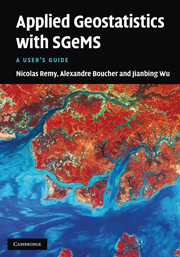Book contents
- Frontmatter
- Contents
- Foreword by Albert Tarantola
- Preface
- List of programs
- List of symbols
- 1 Introduction
- 2 General overview
- 3 Geostatistics: a recall of concepts
- 4 Data sets and SGeMS EDA tools
- 5 Variogram computation and modeling
- 6 Common parameter input interfaces
- 7 Estimation algorithms
- 8 Stochastic simulation algorithms
- 9 Utilities
- 10 Scripting, commands and plug-ins
- Bibliography
- Index
4 - Data sets and SGeMS EDA tools
Published online by Cambridge University Press: 05 November 2011
- Frontmatter
- Contents
- Foreword by Albert Tarantola
- Preface
- List of programs
- List of symbols
- 1 Introduction
- 2 General overview
- 3 Geostatistics: a recall of concepts
- 4 Data sets and SGeMS EDA tools
- 5 Variogram computation and modeling
- 6 Common parameter input interfaces
- 7 Estimation algorithms
- 8 Stochastic simulation algorithms
- 9 Utilities
- 10 Scripting, commands and plug-ins
- Bibliography
- Index
Summary
This chapter presents the data sets used to demonstrate the geostatistics algorithms in the following chapters. It also provides an introduction to the exploratory data analysis (EDA) tools of the SGeMS software.
Section 4.1 presents the two data sets: one in 2D and one in 3D. The smaller 2D data set is enough to illustrate the running of most geostatistics algorithms (kriging and variogram-based simulation). The 3D data set, which mimics a large deltaic channel reservoir, is used to demonstrate the practice of these algorithms on large 3D applications; this 3D data set is also used for EDA illustrations.
Section 4.2 introduces the basic EDA tools, such as histogram, Q-Q (quantile–quantile) plot, P-P (probability–probability) plot and scatter plot.
The data sets
The 2D data set
This 2D data set is derived from the published Ely data set (Journel and Kyriakidis, 2004) by taking the logarithm of all positive values and discarding the negative ones. The original data are elevation values in the Ely area, Nevada. The corresponding SGeMS project is located at DataSets/Elyl.prj. This project contains two SGeMS objects: Ely1-pset and Ely1-pset-samples.
• The Ely1-pset object is a point set grid with 10, 000 points, constituting a reference (exhaustive) data set. This point set grid holds three properties: a local varying mean data (“lvm”), the values of the primary variable (“Primary”) and the values of a co-located secondary property (“Secondary”).
- Type
- Chapter
- Information
- Applied Geostatistics with SGeMSA User's Guide, pp. 80 - 89Publisher: Cambridge University PressPrint publication year: 2009



